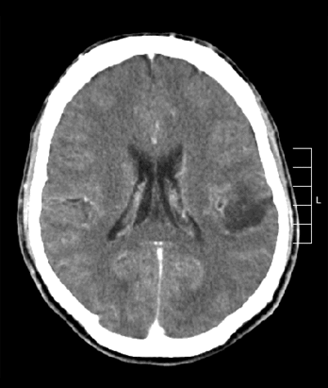Gene Signature Can Predict 3-Year Glioma Survival
Researchers identified a six-gene signature that can help to predict the 3-year survival outcome for patients with grade II or grade III gliomas, independent of the patient’s histology, grade, and IDH1 mutations status.
Glioma of the left parietal lobe, CT scan with contrast enhancement; source: Ninilak, Wikimedia Commons

Researchers identified a six-gene signature that can help to predict the 3-year survival outcome for patients with grade II or grade III gliomas, independent of the patient’s histology, grade, and IDH1 mutations status.
Tim Lautenschlaeger, MD, PhD, of the Ohio State University, presented the results (abstract 2002) of an analysis of the six-gene classifier at the 2014 American Society of Clinical Oncology (ASCO) Annual Meeting.
“The overall survival for an individual glioma patient can be hard to predict,” Lautenschlaeger said. “The overall survival for a grade II patient can range from 5 to 10 years and in grade III patients from 3 to 6 years.”
Previous research has identified several prognostic markers that can help predict survival, such as tumor size, histology, age, or 1p/19q codeleted or IDH1 mutations.
Lautenschlaeger and colleagues used a discovery cohort of 756 patients with glioma to develop a prognostic six-gene signature. To do that, first they analyzed six different gene expression sets that were publically available. They performed survival analysis on each set, and then intersected the results of the analysis of all data sets to identify genes that were significant.
“We identified six genes that were associated with survival in all of the discovery data sets,” Lautenschlaeger said.
Next, they attempted to validate the gene signature in a set of 214 patients with grade II or grade III glioma (TCGM LGG) and a set of 287 patients with grade IV glioblastoma (TCGA GBM).
In the TCGA GBM dataset the classifier identified a low-risk group of patients with excellent outcome with a median overall survival outcome of about 4 years, according to Lautenschlaeger. The high-risk group defined by the classifier showed that hardly any patients were alive at 3 years. Overall, the gene signature was able to predict outcomes in low- vs high-risk patients (HR = 4.03; 95% CI, 1.82-8.92; P = .001). A Cox regression analysis of this cohort showed that the classifier remained a significant predictor of survival on multivariate analysis independent of grade, histology, or IDH1 status.
In the TCGA LGG cohort, the low-risk group was identified as having excellent overall survival with median overall survival of more than 10 years, Lautenschlaeger said. The gene signature also identified a high-risk group with a median overall survival of less than 2 years. In the corresponding Cox analysis, the classifier was again a significant predictor of survival on multivariable analysis independent of grade, histology, or IDH1 status.
Finally, the researchers translated the gene signature into a PCR-based assay and analyzed it in an independent cohort of patients with grade II/III glioma. In this group, the low-risk group had not yet reached a median overall survival, and the assay was able to identify a high-risk group with a median survival of less than 2 years. Again, the assay was found to be a predictive of survival independent of grade, histology, IDH1 status.
ROC analysis for 3-year overall survival demonstrated that the six-gene classifier was also an excellent predictor of 3-year survival in glioblastoma (AUC, 0.84; 95% CI, 0.76-0.91; P < .0001).